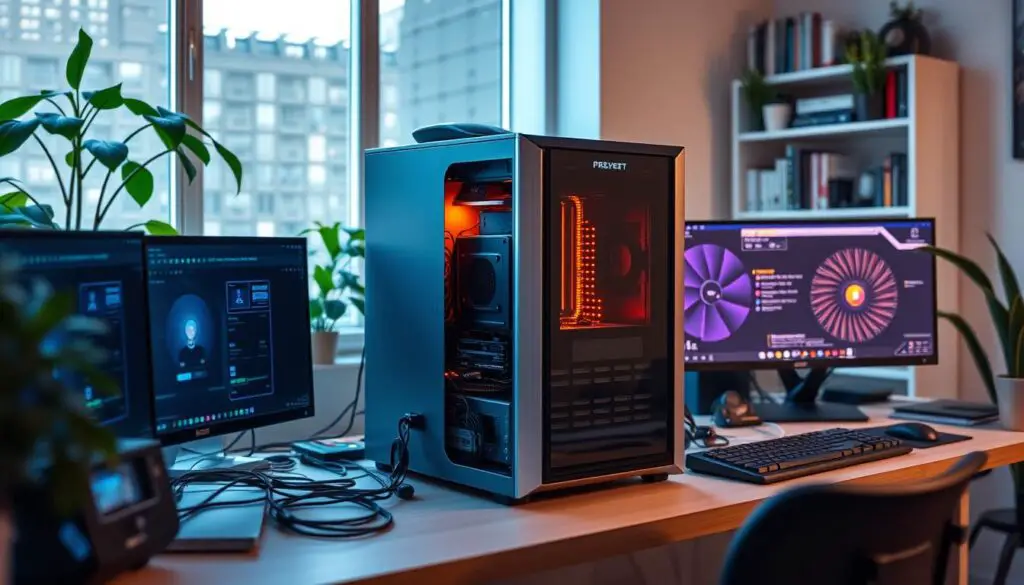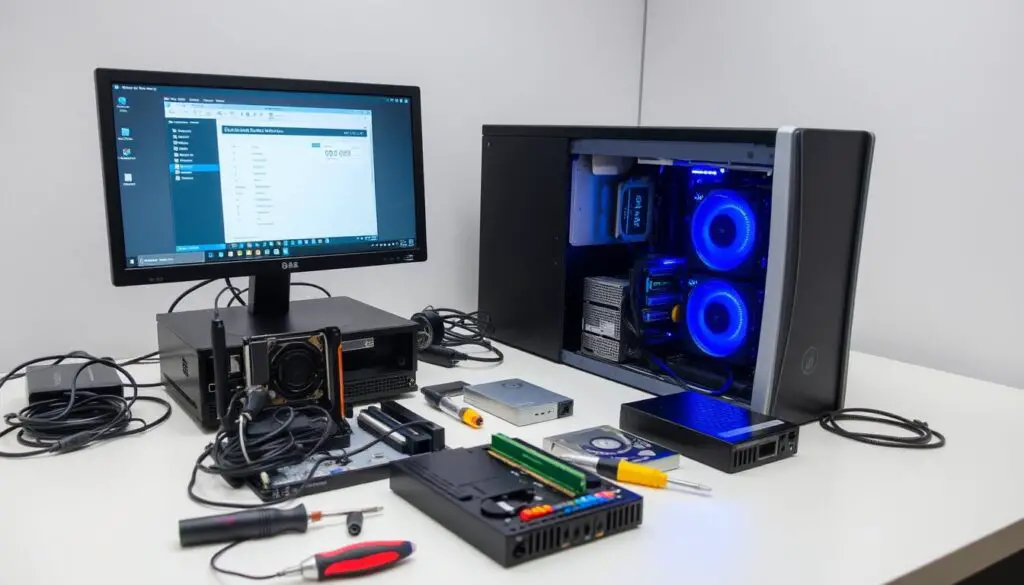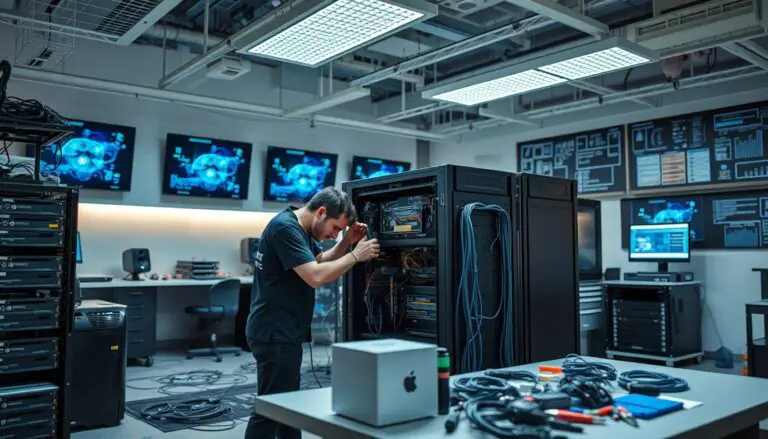
More people are making their own servers to avoid cloud storage costs. Building your own server lets you control your data better. It also saves money in the long run.
When you build your server, you can make it just right for you. You can use Linux, like Ubuntu Server, for a safe and strong setup. You can also add web servers like Apache for smooth work.
Key Takeaways
- DIY server setup allows for significant cost savings and control over your data.
- Linux distributions like Ubuntu Server are preferred for their reliability and security features.
- Web servers like Apache and Nginx facilitate effective server management.
- Implementing SSL/TLS certificates is crucial for securing data transmission.
- Proper backup strategies and security measures are essential for data integrity and loss prevention.
Introduction to Building Your Own Server
Building a personal server is very rewarding. It offers great server benefits and saves money compared to cloud services. Many people, including tech fans and pros, like making their own cloud servers. They want more control over their data and how it’s set up.
Understanding the Benefits
One big plus is better security. You keep your data safe by not using third-party services. Also, making your own server can save a lot of money, especially if you have a lot of data.
Local servers work faster because they have less delay and more speed. They are better than cloud services for moving data around. Plus, you can set up your server just how you need it, without being stuck with what a company offers.
These servers can even do better than before, thanks to new tech. For example, some CPUs are now much faster than before.
Overview of the Process
The first step is to plan what hardware you need. You have to pick the right motherboard and CPU for the best performance. Sometimes, you might need to add more memory to keep up with your work.
After picking your hardware, you need to choose an operating system. Many people choose Linux because it’s flexible and good for servers. Then, you set up your network, making sure it’s fast and can handle lots of devices.
Security is very important. You need to set up firewalls and use encryption to keep your data safe. It’s also good to back up your data every night to avoid losing it.
Comparing Cloud Storage Costs
When looking at cloud storage, it’s key to compare services. This helps us understand the cloud storage pricing from different providers. Let’s dive into the financial side of things.
Analyzing Popular Cloud Storage Providers
We checked out top cloud storage services. Names like Amazon S3, Microsoft Azure, and Google Cloud have many plans. These plans change based on how much storage you need, the number of users, and security.
Amazon S3 is known for being scalable and safe. It uses zero-knowledge encryption and remote wiping. The monthly cost for a cloud server is about $313.90. This depends on how much storage and security you need.
Long-term Cost Implications
Thinking about long-term costs is important. On-premises servers might cost a lot at first. But, they can save money over time, especially for businesses that always need a lot of storage.
Cloud services like Amazon S3 and Google Cloud are flexible and scalable. But, they can cost more over time. This might be more than keeping your own servers.
51% of businesses mix cloud and dedicated servers. They do this to save money and be efficient.
| Provider | Average Monthly Cost | Key Features |
|---|---|---|
| Amazon S3 | $313.90 | Scalability, Data Security, Compliance |
| Microsoft Azure | Varies | Pay-as-you-go, End-to-end Data Protection |
| Google Cloud | Varies | Zero-Knowledge Encryption, Remote Wiping |
Businesses need to think about costs over time. This helps them choose the best cost-effective storage solutions.
Choosing the Right Hardware for Your Server
Building your own server means picking the right parts. This guide helps you make smart choices:
Key Components: Important parts are the motherboard, processor, RAM, and storage. Think about what you need and how it will grow. For example, fast CPUs and lots of RAM are good for lots of tasks.
Server Types: Different needs mean different servers. Knowing what you need helps a lot.
- Tower Servers: Cheap and good for small businesses because they cool well.
- Rack Servers: Save space and work well for many tasks, great for data centers.
- Blade Servers: Pack lots of work into a small space, cool well, and store a lot.
- Hyperconverged Infrastructure (HCI): Combines everything you need for easy setup.
- Mainframes: Best for lots of money transactions, used by banks.
When picking servers, think about CPU, memory, storage, and network. Brands like Asus, Dell, HPE, Fujitsu, and Lenovo have many options.
| Server Type | Advantages | Usage |
|---|---|---|
| Tower Server | Cost-effective, easy cooling | Small businesses with budget constraints |
| Rack Server | Space-saving, versatile | Standard workloads in data centers |
| Blade Server | High processing density, efficient cooling | High-performance computing and storage consolidation |
| HCI | Simplified IT infrastructure, automation | Streamlined deployments for complex environments |
| Mainframe | Handles large transaction volumes | Real-time applications in finance |
Think about your budget and needs. Also, consider security, privacy, and how it will grow. Choosing the right hardware means your server will meet your needs now and later.
Selecting an Operating System
Choosing the right server operating system is key for good server performance. Linux is a top pick because it’s flexible and saves money. But, each OS has its own OS benefits for different needs.

Popular Choices: Linux Distributions
Ubuntu Server, CentOS, and Debian are known for being stable and secure. They also have a big community for help. Linux is open-source, so it’s cheaper than Windows Server.
This makes Linux for servers a great choice for those on a budget. It’s perfect for startups wanting to save money.
Advantages of Different Operating Systems
Linux is great for its flexibility, but Windows Server has its own perks. Windows Server is easy to use and works well with Microsoft products. It’s a good pick for those who prefer Microsoft.
- Cost: Linux is free, which is cheaper than other systems.
- User Experience: Windows Server is easier for those used to Microsoft.
- Security: Both Linux and Windows are secure. But Linux updates faster because it’s open-source.
In short, picking the right server operating system is important. It affects how well your server works. Whether you choose Linux for servers for its control and cost or Windows Server for its ease, it’s a big decision.
Setting Up Your Network
Setting up a server network is key for good performance and safety. Start by setting a static IP address. This makes your server easy to find in your network.
Then, set up a reliable DNS. DNS helps turn domain names into IP addresses. This makes talking between devices smooth.
Managing ports and firewalls is also important. Keep ports 80 and 443 open for web traffic. Firewalls help control who can get in and out.
Nearly 43% of cyberattacks target small and mid-size businesses, highlighting the importance of robust security measures.
Using secure communication protocols is vital. SSL/TLS encryption keeps data safe. Regular updates and patches help fix weak spots.
For small and mid-size businesses, these steps are super helpful. They make your network strong and safe.
| Component | Description |
|---|---|
| Static IP Configuration | Ensures consistent accessibility of the server within the local network. |
| DNS Implementation | Translates domain names into IP addresses for seamless device communication. |
| Port & Firewall Management | Keeps essential ports open and configures firewall rules to manage traffic. |
| Encryption Protocols | Utilizes SSL/TLS to secure data transmission across the network. |
In conclusion, setting up a server network involves several key steps. These include setting IP addresses, DNS, managing ports, and using encryption. Together, they make your server safe and efficient.
Installing and Configuring a Web Server
Setting up a web server is a big step. You can choose between Apache or Nginx. Think about how much traffic you expect and how much memory you have. Both Apache and Nginx are reliable and fast.
Apache vs. Nginx
Choosing between Apache and Nginx depends on what you need:
- Apache: It has lots of help and can be set up in many ways.
- Nginx: It’s great for lots of visitors and uses less memory.
Basic Configuration Steps
Setting up Apache or Nginx needs a few steps:
- Installation: Use your Linux package manager or download from the official site.
- Apache:
sudo apt-get install apache2 - Nginx:
sudo apt-get install nginx
- Apache:
- Security Settings: Make sure ports 80 and 443 are open on your router and firewall.
- Set up the right permissions and keep directories safe
- Configuration: Change the config files to fit your server needs.
- Apache:
/etc/apache2/apache2.conf - Nginx:
/etc/nginx/nginx.conf - Add modules or extensions as needed
- Apache:
- Optimize: Use caching, compression, and other tricks to make your server faster.
Learning about Apache configuration and Nginx server setup helps you make your server better. Linux servers are good because they fight off malware well. Most top servers, 96.3%, run on Linux.
| Feature | Apache | Nginx |
|---|---|---|
| Performance with high traffic | Moderate | High |
| Resource Utilization | Higher | Lower |
| Configuration Complexity | Flexible but complex | Simpler once learned |
| Documentation | Extensive | Comprehensive but less |
Choosing between Apache and Nginx depends on what you need and what you know. Both are great for setting up a web server.
Implementing Security Measures
Keeping your server safe and private is very important. You need to use many technologies and practices to protect it. This includes controlling who can access your server, encrypting data, and finding threats early.
SSL/TLS Encryption
Setting up SSL/TLS setup is key to keeping data safe. It makes sure data sent between your server and users stays secret. Here’s why SSL/TLS is important:
- Data Encryption: SSL/TLS makes data unreadable to anyone without the right key.
- Identity Verification: It checks if the server talking to your users is really yours, stopping fake sites.
- Trust Establishment: SSL/TLS shows HTTPS in browsers, making users feel safe.
Firewall and Intrusion Detection Systems
Firewalls and intrusion detection systems work together to make your server safer. They each do different things to protect your server.
- Firewall for Server: A good firewall only lets in what you need, making your server less open to attacks.
- Intrusion Detection Systems: These watch for strange network activity. They send alerts fast, adding an extra layer of protection.
Also, using Virtual Private Cloud (VPC) networks can help a lot. These networks keep your server safe from the internet. They make sure only trusted people can get in. Cloud network security uses many tools and rules to keep networks safe.
- It gives you a clear view of your network’s security with tools that watch and manage everything.
- It makes it easier to set up and follow rules for your network.
- It finds and stops threats right away, thanks to advanced tech and partners.
- It automates some tasks, so you can grow without getting overwhelmed.
The table below shows what makes a strong server security plan:
| Security Measure | Purpose | Benefits |
|---|---|---|
| SSL/TLS Setup | Encrypt data in transit | Confidentiality, identity verification, trust establishment |
| Firewall for Server | Restrict access to necessary services | Reduce attack surface, improve security |
| Intrusion Detection Systems | Monitor network traffic for suspicious activity | Early detection of potential breaches |
| VPC Networks | Provide private network connections | Inaccessible from the public internet, secure resource connections |
still paying for cloud spaces ! you can build your own server by these steps
If you want to eliminate cloud storage costs, making your own server is a great idea. This guide will help you set up a server. It’s a cheaper way to avoid cloud storage fees.
To start, follow these important steps:
- Pick the right operating system. Look at free, open-source options like CentOS or Ubuntu Server. They are strong choices for a server.
- Get the right hardware. You’ll need a good CPU, enough RAM (at least 8GB), and lots of storage (over 40GB).
- Put a cloud storage program on it. NextCloud is a great open-source tool for your own cloud storage server.
- Make your server safe. Use SSL certificates from Let’s Encrypt for secure web access.
- Back up your data. Regular backups keep your important files safe.
- Keep your server running well. Update software and check performance to keep your server safe.
Using these steps, you can switch from cloud storage to your own server. You’ll learn about the benefits of owning a server. You’ll save money and have more control over your data.

| Service | Monthly Cost | Annual Cost |
|---|---|---|
| Typical Cloud Storage (e.g., Dropbox, Google Drive) | $12 | $144 |
| Personal Server (Initial Setup) | $0 (open-source software) | $0 (excluding hardware) |
| Security Maintenance (SSL, backups) | $0 (Let’s Encrypt) | $0 (Let’s Encrypt) |
Switching to a personal server can save a lot of money. It’s a good and flexible option. By following this build server guide, you can make a server that works just for you.
Conclusion
Building your own server has many benefits. You get to control your data and save money. It also means you don’t have to rely on big cloud services.
This guide showed you how to pick the right parts and keep your server safe. You learned about SSL/TLS encryption.
Managing your own server makes you more tech-savvy. You won’t have to deal with high fees or strict data rules. You can make your server just how you want it, for your own needs.
Following these steps will make you confident in managing your own server. It helps you understand how our digital world works. Start now and feel proud of your data setup.
FAQ
What are the main benefits of building my own server?
Building your own server saves money in the long run. It lets you customize performance and keep your data private. You also avoid monthly fees from cloud services.
How do I get started with planning the hardware specifications for my server?
Pick hardware based on how fast it is, how much storage you need, and how much power it uses. Make sure it’s compatible and fits your budget. Good choices include Intel or AMD processors, lots of RAM, and fast storage like SSDs.
Which operating system is best for my server?
The best OS depends on what you need. Linux, like Ubuntu or CentOS, is great for its stability and security. Windows Server has its own benefits. Think about what you need to choose the right one.
How do I set up the network for my server?
Set up a static IP address and DNS. Manage ports and firewalls. Use secure protocols for network communication. Follow guides to do this right for the best performance and security.
What are the differences between Apache and Nginx for setting up a web server?
Apache is flexible and well-documented. Nginx is fast and good with lots of traffic. Choose based on your needs. Follow setup steps for each.
How can I ensure that my server is secure?
Use SSL/TLS encryption for data safety. Set up firewalls and intrusion detection. Update software regularly. Stay secure by following these steps.
What are the long-term cost implications of building a personal server vs. using cloud storage?
Building a server costs a lot upfront. But it saves money over time. Cloud storage fees add up, making a server cheaper in the long run.
Can I really eliminate my cloud storage costs by building my own server?
Yes, a personal server can cut out cloud storage costs. It needs an initial investment and upkeep. But it saves money and gives you control over your data.
What is involved in setting up and maintaining a personal server?
Setting up a server means planning hardware, choosing an OS, and setting up the network. You also need to configure web servers and secure it. Regular updates and checks keep it running well.



